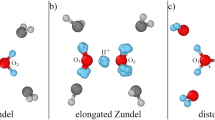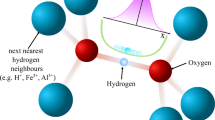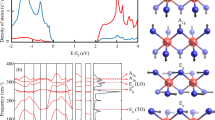Abstract
The transfer of protons involved in hydrogen bonding is fundamental to many chemical and biological processes. Quantum tunnelling can play an important role in this process1,2. It manifests itself in strong isotope effects3,4 and has been observed directly in the solid state5. The tunnelling behaviour seen in such studies usually displays the characteristics of a particle confined in a double-well potential. But proton tunnelling can also occur in a coordinated fashion that involves many hydrogen bonds simultaneously. Such a process may significantly affect the properties of linear and circular networks of hydrogen bonds, which occur in ice and in macromolecules containing hydroxyl groups6,7. Here we report the direct observation by NMR relaxometry of coordinated proton tunnelling in a cyclic array of four hydrogen bonds in solid p-tert-butyl calix[4]arene at low temperature. We are able to quantify the parameters that describe this phenomenon and find good agreement with theoretical predictions for phonon-assisted tunnelling8.
This is a preview of subscription content, access via your institution
Access options
Subscribe to this journal
Receive 51 print issues and online access
$199.00 per year
only $3.90 per issue
Buy this article
- Purchase on Springer Link
- Instant access to full article PDF
Prices may be subject to local taxes which are calculated during checkout



Similar content being viewed by others
References
Liu, K. et al. Characterisation of a cage form of the water hexamer. Nature 381, 501–503 (1996).
MacGillivray, L. R. & Atwood, J. L. Achiral spherical molecular assembly held together by 60 hydrogen bonds. Nature 389, 469–472 (1997).
Bahnson, B. J. et al. Alink between protein structure and enzyme catalyzed hydrogen tunneling. Proc. Natl Acad. Sci. USA 94, 12797–12802 (1997).
Aguilar-Parrila, F., Klein, O., Elgeuro, J. & Limbach, H. H. Adynamic 15N NMR study of kinetic hydrogen/deuterium isotope and tunnel effects on the triple proton transfer in crystalline 3,5-dimethylpyrazole. Ber. Bunsenges. Phys. Chem. 101, 889–901 (1997).
Oppenländer, A., Rambaud, C., Trommsdorff, H. P. & Vial, J. C. Translational tunnelling of protons in benzoic-acid crystals. Phys. Rev. Lett. 63, 1432–1435 (1989).
Saenger, W. Circular hydrogen bonds. Nature 279, 343–344 (1979).
Saenger, W., Betzel, Ch., Hingerty, B. & Brown, G. M. Flip-flop hydrogen bonding in a partially disordered system. Nature 296, 581–583 (1982).
Skinner, J. L. & Trommsdorff, H. P. Proton transfer in benzoic acid crystals: A chemical spin-boson problem. Theoretical analysis of nuclear magnetic resonance, neutron scattering, and optical experiments. J. Chem. Phys. 89, 897–907 (1988).
Diamond, D. & McKervey, M. A. Calixarene-based sensing agents. Chem. Soc. Rev. 25, 15–24 (1996).
Andreetti, G. D., Ungaro, R. & Pochini, A. Crystal and molecular structure of cyclo{quarter[(5-t-butyl-2-hydroxy-1,3-phenylene)methylene]}toluene (1:1) clathrate. J. Chem. Soc. Chem. Commun. 1005–1007 (1979).
Andrew, E. R. & Latanowicz, L. Solid-state proton transfer dynamics and the proton NMR second moment and proton relaxation rates. J. Magn. Reson. 68, 232–239 (1986).
Brougham, D. F., Horsewill, A. J. & Jenkinson, R. I. Proton transfer dynamics in the hydrogen bond: adirect measurement of the incoherent tunnelling rate by NMR and the quantum-to-classical transition. Chem. Phys. Lett. 272, 69–74 (1997).
Landau, L. D. & Lifshitz, E. M. Quantum Mechanics 177 (Pergamon, Oxford, (1958)).
Acknowledgements
This work was supported by the Engineering and Physical Sciences Research Council (EPSRC) and the Istituto Nazionale per la Fisica della Materia.
Author information
Authors and Affiliations
Corresponding author
Rights and permissions
About this article
Cite this article
Brougham, D., Caciuffo, R. & Horsewill, A. Coordinated proton tunnelling in a cyclic network of four hydrogen bonds in the solid state. Nature 397, 241–243 (1999). https://doi.org/10.1038/16672
Received:
Accepted:
Issue Date:
DOI: https://doi.org/10.1038/16672
This article is cited by
-
Direct visualization of concerted proton tunnelling in a water nanocluster
Nature Physics (2015)
-
Protons in concert
Nature Physics (2015)
Comments
By submitting a comment you agree to abide by our Terms and Community Guidelines. If you find something abusive or that does not comply with our terms or guidelines please flag it as inappropriate.



